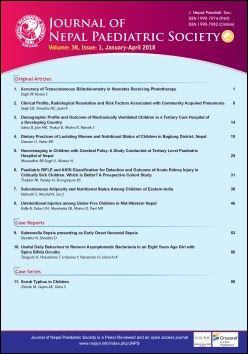Subcutaneous Adiposity and Nutritional Status Among Children of Eastern-India
DOI:
https://doi.org/10.3126/jnps.v38i1.18750Keywords:
Anthropometry, Body Composition, Nutritional Assessment, Skinfold thickness, Sexual Dimorphism, Subcutaneous AdiposityAbstract
Introduction: Skinfold thickness is now considered to be an important indicator of body composition and nutritional status. Assessment of subcutaneous adiposity is becoming very important due to increasing trend of overweight and obesity. The objectives of the present study were to determine age-sex specific subcutaneous adiposity using skinfold thicknesses and its use in assessment of nutritional status among children of Eastern-India.
Material and Methods: The investigation was carried out among 1262 children (619 boys; 643 girls) aged 5–12 years of Darjeeling district, West Bengal. Anthropometric measurements of skinfold thickness were recorded using standard procedures. Age-sex specific smooth percentile curves of skinfold thickness were derived using the L, M and S model.
Results: Sexual dimorphism was observed in TSF, SSF, SISF, PBF, Σ2SKF and Σ4SKF measurements between sexes in children (p<0.05). Age-sex specific mean values of skinfold thicknesses of TSF, SSF, SISF and PBF of girls were observed to be significantly higher than boys (p<0.05). The age-sex specific mean values of BSF, TSF, SSF, SISF, Σ4SKF and PBF did not show any age-specific trend in children. Comparison with the NHANES-III data showed poor attainment of subcutaneous adiposity and nutritional status.
Conclusion: Results of the present study showed the age-sex specific variations in subcutaneous adiposity pattern in children. The comparisons of skinfold thicknesses with references showed unsatisfactory nutritional status among children. These findings are important for future investigations in field, epidemiological and clinical settings.
Downloads
Downloads
Additional Files
Published
How to Cite
Issue
Section
License
Authors who publish with this journal agree to the following terms:
Authors retain copyright and grant the journal right of first publication with the work simultaneously licensed under a Creative Commons Attribution License that allows others to share the work with an acknowledgement of the work's authorship and initial publication in this journal.
Authors are able to enter into separate, additional contractual arrangements for the non-exclusive distribution of the journal's published version of the work (e.g., post it to an institutional repository or publish it in a book), with an acknowledgement of its initial publication in this journal.
Authors are permitted and encouraged to post their work online (e.g., in institutional repositories or on their website) prior to and during the submission process, as it can lead to productive exchanges, as well as earlier and greater citation of published work (See The Effect of Open Access).



